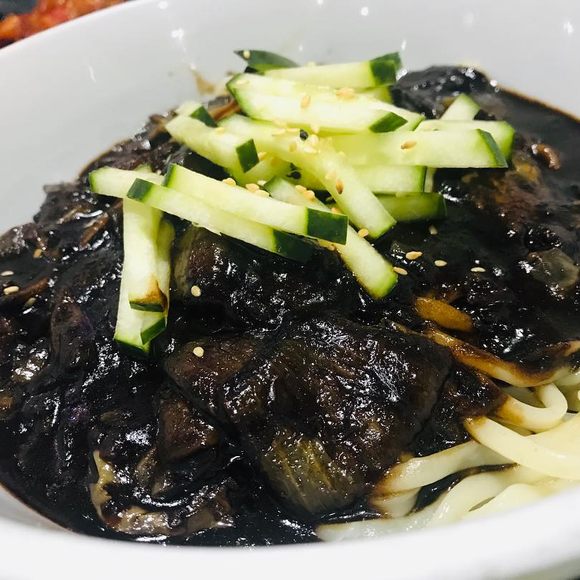Prepared Foods
Jjajang Myeon
On April 14, lonely South Korean singles are encouraged to drown their sorrows in black noodles.
Each April 14, lonely South Korean singles are encouraged to dress in black and commiserate over steaming bowls of noodles in black bean sauce. Called jjajang myeon, the dish reveals the history of Chinese culinary influence in South Korea, the cleverness of Korean product marketing, and the universal ability of carbs to soothe even the loneliest of hearts.
Called South Korea’s “Black Day” for singles, the April holiday originated in the midst of other, more romantic Valentine’s Day promotions. While some of the first advertisements for Valentine’s Day in Asia appeared in Japan in the 1930s, it wasn’t until the ’60s and ’70s that the holiday truly took off in both Japan and South Korea. By then, chocolate manufacturers were capitalizing on the imported Western holiday as a way to sell their wares, leading to the tradition of Japanese and Korean women gifting chocolate to their male friends and romantic partners on February 14. In 1978, another clever confectioner got in on the advertising game, declaring that March 14 would be “White Day,” a time for men to give marshmallows and white chocolate to their female romantic partners.
South Koreans took these celebrations to the next level, informally declaring April 14 Black Day for singles. These days, the unofficial holiday has taken off, with black-clad singles gathering to eat jjajang myeon and sip black coffee, and clever marketers sponsoring promotional deals and jjajang myeon eating contests.
This starring role in South Korea’s celebration of singledom isn’t the only thing that sets jjajang myeon apart. The meal is a satisfying, savory mix of wheat noodles, fermented bean paste, vegetables, and meat or seafood, eaten alongside a signature pickled yellow radish. It originated in the early 20th century in Incheon, which contains South Korea’s largest Chinatown. Made by a Chinese chef from Shandong Province, the meal was initially a take on a typical North Chinese noodle and ground pork dish. It quickly took on local flavors, its sauce gaining a caramelized sheen beloved by Koreans today. Nowadays, jjajang myeon is a takeout staple from Chinese restaurants across South Korea. The dish comes in a tin box, which diners can place back on their doorsteps for pickup after the meal.
While this humble but iconic delivery staple has come a long way from its roots, jjajang myeon is becoming increasingly popular in its Chinese homeland. Call it the noodle circle of life.
Where to Try It
-
Sinseonggak 신성각
2-463 singongdeok-dong , Mapo-gu, Seoul, South KoreaThis Chinese restaurant uses handmade noodles in their jjajang myeon.
-
This spot's jjangjang myeon comes with pork belly.
Written By
 Reina Gattuso
Reina Gattuso
Sources
- www.maangchi.com/ingredient/black-bean-paste
- www.youtube.com/watch?v=OuYoX4V6CyQ
- www.koreanbapsang.com/jajangmyeon-noodles-in-black-bean-sauce/
- chefjulieyoon.com/2016/01/noodles-in-black-bean-sauce-jjajangmyeon-jajangmyeon/
- kimchimari.com/jjajang-myeon/
- www.smithsonianmag.com/arts-culture/koreas-black-day-when-sad-single-people-get-together-and-eat-black-food-16537918/
- uk.reuters.com/article/oukoe-uk-korea-blackday/south-koreas-black-day-for-love-idUKSEO18852320080414
- www.nytimes.com/2016/04/03/magazine/a-korean-noodle-dish-for-lonely-hearts.html
- blog.rushorderapp.com/post/170618218992/jjajangmyeon-a-shared-cultural-icon














